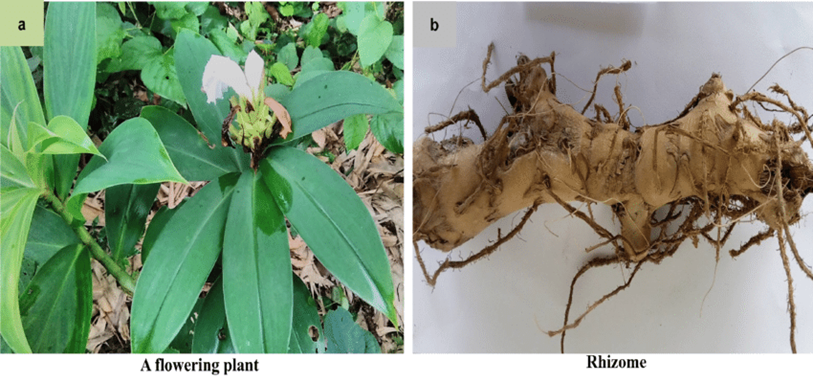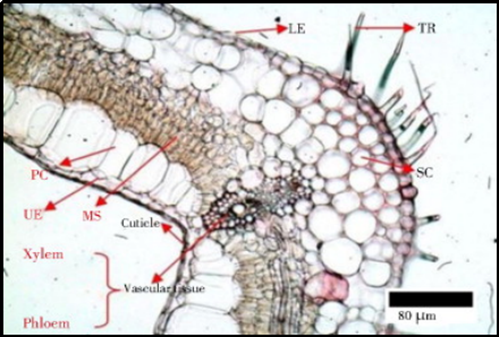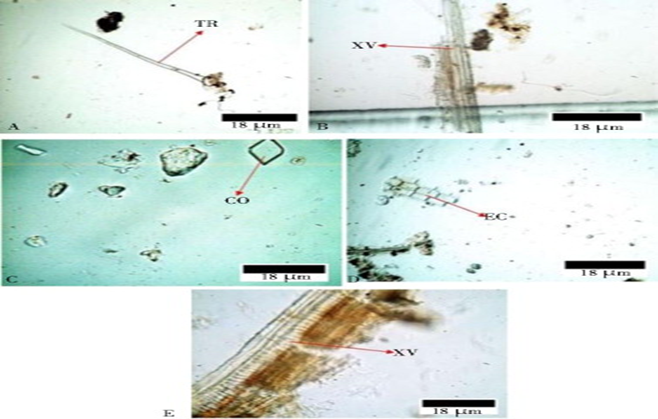Abstract
Keukand, a traditional medicinal plant, has been used for centuries in various cultures. Its bioactive compounds exhibit promising pharmacological activities. Rhizomes are given in pneumonia, rheumatism, dropsy, urinary diseases, jaundice while leaves are given in mental disorders. Bruised leaves are applied in fever; decoction of stem is used in fever and dysentery. Various other activities are also reported like anti-inflammatory, antiarthritic effect and antifungal activities. The plant is also used in gout rheumatism and bronchial asthma. Rhizomes of plant exhibit cardiotonic hydrochloretic, diuretic and CNS depressant activities. The present review reveals information about distribution, morphology, chemical constituents, traditional, pharmacological and medicinal uses of Costus speciosus, need for its conservation and different conservation methods using biotechnological approaches.
Keywords
Costuos speciosus, Keu, Antimicrobial activity, traditional use, Syrup, Nematoda.
Introduction
Medicinal plant have been of great importance to the health care needs of individuals and their communities. The use of herbal preparations made from medicinal plants is widespread in developing countries [1]. Medicinal herbs are moving from fringe to mainstream use with a greater number of people seeking remedies and health approaches free from side effects caused by synthetic chemicals [2] . In Ayurveda, where the rhizome has been used to treat, asthma, bronchitis, and intestinal warm, costous specious used for the treatment of smallpox and purgative. Hence, costs specious plants are traditionally, medicinally, and pharmacologically important. Costus speciosus is an important medicinal and ayurvedic plant[3]. At the present juncture, the modern conventional health care is burdened with great problems of unsafe medicines, chronic diseases, resistant infections, autoimmune disorders and degenerative disorders of ageing, despite great scientific advantages[4]. The C. speciosus rhizomes are bitter, astringent, expectorant, tonic, and improve digestion [5].Also, the rhizomes exerted anti-fertility and anabolic actions. Furthermore, the rhizomes extract encourages uterine contraction [6]. The rhizomes also showedcardiotonic and central nervous system (CNS) depressant efficacy. The herb has a red color fruit, whereas the seeds are black [7].

Fig : 1.1 Costus Specisus Flower And Rhizome
Biological Sources:
Heilocostus Speciosus, or crepe ginger, is a species of flowering plant in the family Costaceae. Some botanists have now revived the synonym Hellenia speciosa for this species. Medicinal plants have been of great importance in human culture to meet the primary health care needs. Many people in developing countries use medicinal plants as traditional drugs. According to World Health Organization, up to 80% of the world's population relies on traditional medicinal system for some aspect of primary health care [8]. The healing powers of traditional herbal medicines have been realized since antiquities. About 65% of the world populations have access to local medicinal plant nowledge system. India is sitting on a gold mine of well-recorded and traditionally well-practiced knowledge of herbal medicine. India has an officially recorded list of 45,000 plant species and estimation put the list of 7500 species of me.[10]
Scientific classification:
Kingdom: Plantae
Clade: Tracheophytes
Clade: Angiosperms
Clade: Monocots
Clade: Commelinids
Order: Zingiberales
Family: Costaceae
Genus: Cheilocostus
Species: C. speciosus
Taxonomic Classification:
Kingdom - Plantae
Subkingdom – Tracheobinota
Super Division - Spermatophyta
Division - Mangoliophyta
Class – Liliopsida
Sub Class - Zingiberidae
Order - Zingiberales
Family - Costaceae
Genus - Costus
Species – Speciosus
Vernacular names:
Assam: Tara
Bengali: Keu, Keumut
English : Spiral flag
Guajarati : Paskarmula, Valakdi
Hindi: Keu, Keukand, Kemuka, Kemua
Kannad : Changalvakostu, Chikke
Malayalam: Channakoova
Marathi : Penva, Pinnha, Kobee, Peva
Tamil: Kostam
Telegu : Kashmeeramu, Cengalvakostu
Sanskrit: Kembuka, Kebuka, Kembu
Microscopy: C. speciosus is an ornamental, perennial, erect, succulent herb, up to 2.7 m in height, arising from a horizontal rhizome. Leaves are alternate, spirally arranged, sub sessile, elliptic to oblong or oblong-lancoelate, acuminate apex, thick, 15-35 cm×6-10 cm, glabrous above, silky pubescent beneath, with stem clasping sheaths up to 4 cm forming a complete tube around stem, flowers large, white, in thick, cone-like terminal spikes, with bright red bracts Leaf lamina possessed 5 to 6 parallel veins on both sides of midrib No characteristic taste and odour was found.[11]

Fig: 1.2 Costus Speciosus
Table 1. Organoleptic evaluation of leaves of C. speciosus.
|
Empty Cell
|
|
Leaves of Costus speciosus
|
|
Empty Cell
|
|
Stem
|
Flowers
|
|
Colour Dark Green
|
|
Pale Brown
|
White
|
|
Odour No Characteristic
|
|
odour No characteristic odour
|
Characteristic odour
|
|
Taste No Characteristic
|
|
;ic taste No characteristic taste
|
Characteristic taste
|
Geographical Source:-
The plant is widely distributed in India in the tropical or sub-tropical climate from the sea level to the Himalayas , excluding the arid and semi-arid areas of Punjab , Haryana, Rajasthan , Gujarat and the peninsular India.[12] It is found throughout the country in moist tropical evergreen forest, up to an altitude of 1200 m. It is common along roadsides, streams and in wasteland[13] . It widely distributed in Assam , Meghalaya, Bihar, Khasi , and Jaintia Hills , Uttaranchal, Orissa, MP, North Bengal. The Himachal sub Himalayan tracts and western ghats are the ideal places for its collection.[14]
Powder microscopy:
Powder is dark green to brown, with no specific odour or taste. It is easily flowable with a fine to coarse texture. Diagnostic microscopic powder features include prismatic and clusters crystals of calcium oxalate; starch granules are mostly simple, but rarely compound; unicellular and uniseriate multicellular covering trichomes; parts of epidermis in surface view showing straight-walled polygonal epidermal cells, paracytic stomata and spiral xylem vessels.[15]

Fig: 1.3 Powder Microscopy
Morphology : Plant, rootstock tuberous stem, sub-wood at the base, thick creep in rhizomes (120-300 cm height) (16). it grows upto2-2.7m in height with long lanceolate leaves and white fragrant flowers in terminal clusters (17). It is a dramatic landscape plant with large dark green, subsessile, elliptic, or obovate leaves arranged on the stalk in spiral form. It can grow up to 3.1 m in height in frost-free areas but usually grows to about 1.8 m tall in cooler areas where its roots get hardened but die back in winter. (18) The plant flowers during July and August and, the aerial parts wither away during the winter season. (19) The Costus specious plant flowers look like crepe paper, thus the common name is "Crepe ginger". The flowers are 5-6 cm long with a cup-shaped labellum and crest yellow stamens. Fruit is red in color whereas seeds are black, five in number with a white fleshy aril.[20]
Phytochemicals: Sequential screening for phytochemicals of C. igneus leaves revealed that it is rich in protein, iron, and antioxidant components such as ascorbic acid, ?-tocopherol, ?-carotene, terpinoids, steroids, and flavonoids [21]. It was revealed in another study that methanolic extract was found to contain the highest number of phytochemicals such as carbohydrates, triterpenoids, proteins, alkaloids, tannins, saponins, and flavonoids[22] Preliminary phytochemical evaluation of Insulin plant (C. pictus) revealed that the leaves contain 21.2% fibers. Successive extracts gave 5.2% extractives in petroleum ether, 1.06% in cyclohexane, 1.33% in acetone, and 2.95% in ethanol. Analysis of successive extracts showed presence of steroids in all extracts. The ethanol extract contained alkaloid also. The major component of the ether fraction was bis (2’-ethylhexyl)-1,2-benzenedicarboxylate (59.04%) apart from ?-tocopherol and a steroid, ergastanol [23].
Traditional Uses:
Costus is regarded to be tonic, stomachic, carminative, stimulant, spasmodic in asthma, as well as replacement in chronic skin disease. medicine to counter various diseases such as cough, cold, fever, and stomach ache. Other medicinal formulations are also sometimes prepared from costus, which are used for chest pain and headache [24]. Juice of the rhizome is use to provide cooling to head and relief from headache [25]. an Costus speciosus rhizomes alkaloidal extract had smooth muscle relaxant, antispasmodic activities in experimental animals [26]. Rhizomes are also use in rheumatism, urinary diseases, pneumonia, dropsy, jaundice and leaves are used in psychic disorders Leaf extract is utilized as an antioxidant [27].
Pharmacological actions:
Antidiabetic activity & hypolipidemic activity:
Diabetes mellitus is a chronic disease characterized by high blood glucose levels due to absolute or relative deficiency of circulating insulin levels [28].Diabetes mellitus is a metabolic disorder progress chronically and affecting approximately 4% of world population and is expected to increase drastically to 5.4% in 2025. Various clinical trials and epidemiological studies gives strong evidence of hyperglycemia is the primary cause of complications such as cerebrovascular disease, coronary artery disease, kidney failure, visual disturbances, limb amputation, neurological complications and premature death [29].
Antifungal activity: the saponins and sapogenins were isolated from C. speciosus by column chromatography and their structures were determined by spectral analysis. Antifungal activity of avinocoside-A, tigogenin, saponin B and saponin C were tested on Alternaria sp., A. tenuissima, Botrytis cinerea, Fusarium lini, Curvularia sp. and Sclerotinia sclerotiorum invitro. Saponin B and avinocoside-A at 2.5 mg/ml were highly effective against conidial germination of B. cinerea and Alternaria sp., and A. tenuissima and F.[30]
Anti-Inflammatory & Antipyretic Properties:
The ethanolic extract of the rhizome of Costus speciosus possesses anti-inflammatory and antipyretic properties. Anti-inflammatory property was studied in carrageenan induced paw oedema and cotton pellet induced granuloma formation. Significant anti-inflammatory effect was found against carrageenan induced oedema formation in rats at a dose of 800 mg/kg and against cotton pellet granuloma formation in rats at doses of 400 mg/kg and 800 mg/kg. The antipyretic property was studied in yeast-induced pyrexia in rats. The antipyretic effect was only minimal and was observed only at 800 mg/kg dose [31].
Introduction of Nematoda: The Nematoda is a phylum comprising invertebrates commonly known as ‘roundworms’ lacking true segments and appendages.They are distributed worldwide and occur in a wide range of habitats. While many are free-living with activities inconsequential to humans, others parasitize plants and animals, including humans, and are of economic importance [32].
Formulation and Evaluation of Herbal Syrup on Nematoda:
- The main objective of this present work is to formulate and evaluate herbal syrup which have less side effect than synthetic syrup, most used for prediatic patient.
- The prepared Formulation was evaluate by different parameter like PH, Terbidity, specific Gravity, Sedimentation percentage, Density, Viscosity, Physical appearance.
CONCLUSION:
The aim of this project was to formulate and evaluate:
herbal anitimicrobil syrup. The present study helped us to understand what actually means, what are differenttypes of nematode parasites factors responsible for causing aound warm. Herbal treatments for nematode were studied briefly. As thestudy shows that the herbal treatment is beneficial than that of allopathy treatment which uses standard drugsfor treatment as Herbal drugs have less or no side effects. Herbal treatments are more preferred widely. Herbaldrugs are easy to available than that of prescribed drugs.This study helpsus to understand aound warm and measures tobe taken in order to avoid aound warm. The pre-formulationstudies of all three formulations were within specification. formulations were prepared and evaluation test such as colour, odor, taste and pH were performed. The present study will help us to understand effectiveness of herbal antimicrobial syrup compared to chemical- based syrup.
REFERENCES
- J. Okpuzor1, A. M. Oloyede, Nature and Science, 2009, 7(8), 89-94
- N. K. Dubey, R. Kumar, P. Tripathi, Current Science, 2000, 86(1), 37.
- H. EL - far, and I. I. Abou - Ghanema, Biochemical and hematological evaluation of Costusspeciosus as a dietary supplement to Egyptian buffaloes,” African Journal of Pharmacy and Pharmacology, 7(42), pp. 2774- 2779, 2013.
- Surendra kumar Muniyadi, Aswathy Tharyil Nandanan, Suhail CherachanVeetil, Sreena Kanakkanath, Astalakshmi Narayanan and Babu Ganesan; Scholars Research Library, 2013, 5 (4), 283- 285.
- Bavarva JH. Narasimhacharya AVRL. Antihyperglycemic and hypolipidemic effects of Costusspeciosus in alloxaninduced diabetic rats. Phytotherapy. Res. 2008; 22(5): 620–626.
- Lijuan W, Kupittayanant P, Chudapongse N, Wray S, Kupittayanant S. The effects of wild ginger ( Costusspeciosus (Koen) Smith) rhizome extract and diosgenin on rat uterine contractions. Reproductive Sci. 2011; 18(6):516–524.
- Pawar VA, Pawar PR. Costusspeciosus: An important medicinal plant. Inter. J. Sci. Res. 2014; 3(7): 28–33.
- Okpuzor1, A. J M. Oloyede, Nature and Science, 2009, 7(8), 89-94
- H. Tag, A. K. Das, H. Loyi, Natural Product Radiance, 2007, 6(4), 334-340
- Anonymous; The Wealth of India: First Supplement Series (Raw Materials), National Institute of Science Communication and Information Resources, CSIR, 2007, Vol 2, 211, 213.
- Wealth of India Division, CSIR-National Institute of Science Communication and Information Resources.
- Anonymous; The Wealth of India: First Supplement Series (Raw Materials), National Institute of Science Communication and Information Resources, CSIR, 2007, Vol 2, 211, 213.
- A. K. Gupta, N. Tondon, M. Sharma; Quality Standards of Indian Medicinal Plants, Medicinal Plants Unit, Published by Indian Council of Medical Research, Vol VII, 2008, 48.
- A. K. Gupta, N. Tondon, M. Sharma; Quality Standards of Indian Medicinal Plants, Medicinal Plants Unit, Published by Indian Council of Medical Research, Vol VII, 2008, 48.
- R. K. Gupta; Medicinal and Aromatic Plants, CBS Publishers and Distributors, 2010, 234, 499.
- CP KhareIndian medicinal plants: an illustrated dictionary, Springer, Berlin (2007), pp. 181-182Google Scholar
- N. Choudhury, K. J. Chandra and H. Ansarul “Effect of Costusspeciosus Koen on reproductive organs of female albino mice,” International Research Journal of Pharmacy, 3(4), pp. 200-202, 2012.
- N. Choudhury, K. J. Chandra and H. Ansarul “Effect of Costusspeciosus Koen on reproductive organs of female albino mice,” International Research Journal of Pharmacy, 3(4), pp. 200-202, 2012.
- V. Devi D and A. Urooj, "Nutrient Profile and Antioxidant components of Costusspeciosus Sm. And CostusigneusNak.," Indian Journal of Natural Products and Resources, 1(1), pp. 116-118, 2010.
- Eti, A. Narayanan, B. Ganesan, "Studies on Costus speciosus Koen Alcoholic Extract for Larvicidal Activity, "International Journal of Pharmacognosy and Phytochemical Research, 5(4), pp. 328-329, 2013.
- Nehete, M. Bhatia and M. Narkhede, “In-vitro Evaluation of Antioxidant Activity and Phenolic Content of Costusspeciosus (Koen) J. E. Sm.,” Iranian Journal of Pharmaceutical Research, 9(3), pp. 271-277, 2010.
- Devi VD, Urooj A. Nutrient profile and antioxidant components of Costus specious Sm. and Costus igneus Nak. Indian J Nat Prod Resour. 2010;1:1168. [Google Scholar
- Jothivel N, Ponnusamy SP, Appachi M, Singaravel S, Rasilingam D, Deivasigamani K, et al. Anti-diabetic activity of methanol leaf extract of Costus pictus D. Don in alloxan-induced diabetic rats. Journal of Health Science. 2007;53:655–63. [Google Scholar]
- George A, Thankamma A, Rema Devi VK, Fernandez A. Phytochemical investigation of Insulin plant (Costus pictus) Asian J Chem. 2007;19:3427–30. [Google Scholar]
- Seed germination studies of Saussurea costus Clarke, A step towards conservation of a critically endangered medicinal plant species of north western Himalaya.[25] Samir HasanM. Vishalakshi Devi D and AsnaUrooj,Indian Journal of Natural Qari, JKAU science, 2010, Vol. 22,133-152.
- Bhattacharya S. K., Parikh A. K., Debnath P. K., Pandey V. B., Neogy N. C., Journal ofResearch in Indian Medicine, 1973, 8(1), 10-19.
- Vishalakshi Devi D and AsnaUrooj,Indian Journal of Natural Qari, JKAU science, 2010, Vol. 22,133-152 Products and Resources,2010,Vol.1,116-118
- Vishalakshi Devi. D, Urooj A., Indian Journal of Experimental Biology, 2008, 46, 614-616
- Eliza J., Daisy P., Ignacimuthu S., Journal of Health Sciences, 2008, 54(6), 675-681.
- U. P. Singh, B. P. Srivastava, K. P. Singh, V. B. Pandey, Naturalia (Sao Paulo), 1992, 17, 71-77.
- Binny K, Sunil Kumar G, Dennis Thomas, Journal of Basic and Clinical Pharmacy, 2010, 1(3), 177- 181.
- Megen HHB, Elsen SJJ, Holterman MHM, et al. (2009) A phylogenetic ress of nematodes based on about 1200 full-length small subunit ribosomal DNA sequences. Nematology 11: 927–950. ISSN: 1388-5545.


 Dnyaneshwar Sonwane*
Dnyaneshwar Sonwane*
 Grishma Bawankar
Grishma Bawankar
 Aachal Dudhpachare
Aachal Dudhpachare
 Vishakha Chindhalore
Vishakha Chindhalore



 10.5281/zenodo.14744439
10.5281/zenodo.14744439